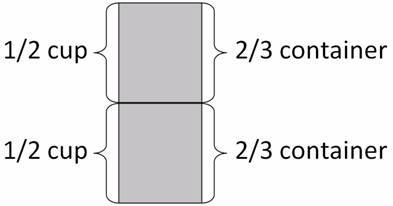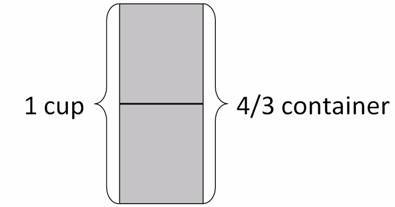How Many Containers in One Cup / Cups in One Container?
Task
-
If \frac12 cup of water fills \frac23 of a plastic container, how many containers will 1 cup fill?
-
Solve the problem by drawing a picture.
-
Which of the following multiplication or divisions problems represents this situation? Explain your reasoning.
\frac12 \times \frac23=? \qquad \frac12 \div \frac23=? \qquad \frac23 \div \frac12=? Solve the arithmetic problem you chose in part (3) and verify that you get the same answer as you did with your picture.
-
-
If \frac12 cup of water fills \frac23 of a plastic container, how many cups of water will the full container hold?
-
Solve the problem by drawing a picture.
-
Which of the following multiplication or divisions equations represents this situation? Explain your reasoning.
\frac12 \times \frac23=? \qquad \frac12 \div \frac23=? \qquad \frac23 \div \frac12=? Solve the arithmetic problem you chose in part (3) and verify that you get the same answer as you did with your picture.
-
IM Commentary
These two fraction division tasks use the same context and ask “How much in one group?” but require students to divide the fractions in the opposite order. Students struggle to understand which order one should divide in a fraction division context, and these two tasks give them an opportunity to think carefully about the meaning of fraction division.
The purpose of this problem is to help students deepen their understanding of the meaning of fractions and fraction division and to see that they get the same answer using standard algorithm as they do just reasoning through the problem. Later they can build on this to explain why dividing by, for example, \frac23 is the same as multiplying by \frac32 based on the meaning of multiplication and division by fractions.
Solution
-
-
Below is a series of pictures that can be used to solve the problem as well as an explanation of what the picture represents at each step.
\frac12cup of water fills \frac23 of a plastic container, as shown below.

We know that \frac12 cup of water fills \frac23 of a plastic container. The question is asking, "How many containers can be filled with 1 cup of water." Since 1 cup of water is twice as much as \frac12 cup of water, we know that 1 cup of water will fill twice as much of a container.

The answer to the question can easily be found by relabeling the above picture.
Twice as much water will fill twice as many containers. Thus, 1 cup of water will fill \frac43 of a container.
-
We are looking for the number of containers filled by 1 cup, and we know \frac12 of that unknown amount fills \frac23 of a container. We can write this symbolically as \frac12 \times ? = \frac23 which is equivalent to \frac23 \div \frac12 Computing this by multiplying by the reciprocal, we find that \begin{align} \frac23 \div \frac12 &=\\ &=\frac23 \times \frac21 \\ &= \frac43 \end{align}
-
When we solved the problem with a picture, we took the fraction of the container filled by \frac12 cup and doubled it to find the fraction of a container filled by one cup. This is exactly what we did when we did it through computations: to divide \frac23 by \frac12 we multiplied it by 2. The two ways of solving it do result in the same answer and even follow the same process.
-
-
-
Below is a series of pictures that can be used to solve the problem as well as an explanation of what the picture represents at each step.
\frac12 cup fills \frac23 of the container, as shown in the picture below.

Since the picture represents \frac23 of the container, \frac12 of \frac23 will be \frac13 of the container. In the picture below, each piece represents \frac12 of \frac23, and also represents \frac12 of \frac12. Since \frac12 \times \frac12 = \frac14, each piece also represents \frac14 cup.

We have \frac23 of the container, but we need to know how many cups it takes to fill \frac33 of the container, so if we take 3 of the thirds, we will have the amount of water needed for the full container. This is the same thing as multiplying 3 \times \frac14.

We can see that \frac34 cup is needed to fill the whole container.
-
We are looking for the number of cups needed to fill one container, and we know \frac23 of that unknown amount requires \frac12 a cup. We can write this symbolically as \frac23 \times ? = \frac12 which is equivalent to \frac12 \div \frac23 Computing this by multiplying by the reciprocal, we find that \begin{align} \frac12 \div \frac23 &=\\ &=\frac12 \times \frac32 \\ &= \frac34 \end{align}
-
When we solved the problem using a picture, we found \frac12 of the amount (because we knew it was 2 thirds of the container, and so \frac12 of that would be 1 third of the container) and then we multiplied that amount by 3 to get the amount in the whole container. This is exactly what we did when we multiplied by the reciprocal of \frac23: multiplying by \frac12 and then by 3 is the same as multiplying by \frac32. So whether we solve it with a picture or via computation, we get the same answer (in fact, the process itself is the same).
-
How Many Containers in One Cup / Cups in One Container?
-
If \frac12 cup of water fills \frac23 of a plastic container, how many containers will 1 cup fill?
-
Solve the problem by drawing a picture.
-
Which of the following multiplication or divisions problems represents this situation? Explain your reasoning.
\frac12 \times \frac23=? \qquad \frac12 \div \frac23=? \qquad \frac23 \div \frac12=? Solve the arithmetic problem you chose in part (3) and verify that you get the same answer as you did with your picture.
-
-
If \frac12 cup of water fills \frac23 of a plastic container, how many cups of water will the full container hold?
-
Solve the problem by drawing a picture.
-
Which of the following multiplication or divisions equations represents this situation? Explain your reasoning.
\frac12 \times \frac23=? \qquad \frac12 \div \frac23=? \qquad \frac23 \div \frac12=? Solve the arithmetic problem you chose in part (3) and verify that you get the same answer as you did with your picture.
-
